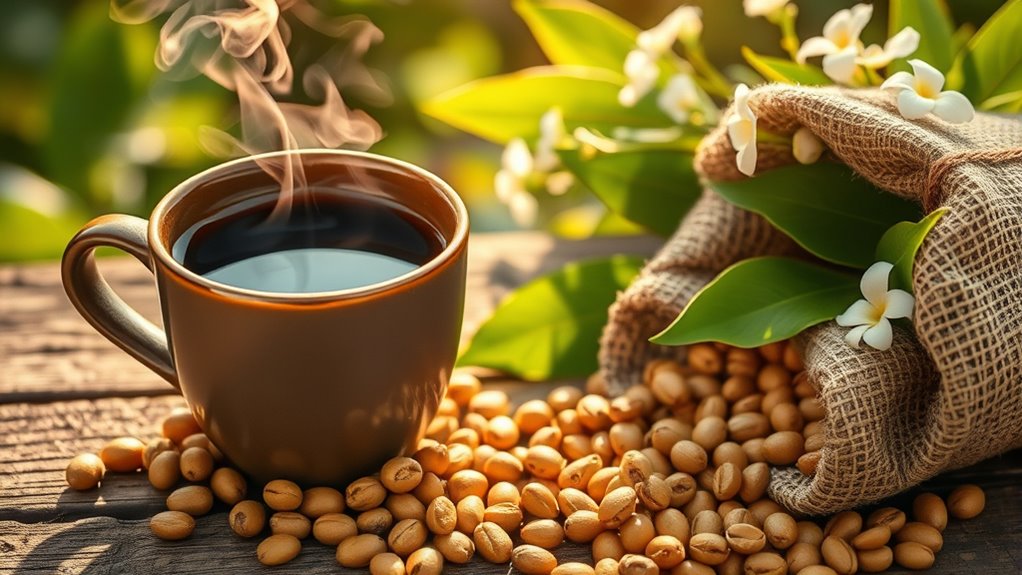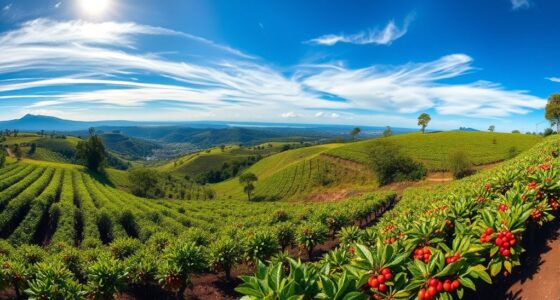Colombian coffee boasts a rich history rooted in tradition, dating back to the 1700s, and is famed for its high quality. The country’s unique geography, with high-altitude mountains and volcanic soils, creates ideal conditions for vibrant, aromatic beans. Cultural practices like hand-picking and sustainable farming keep the quality first-rate. Iconic brands like Juan Valdez symbolize Colombia’s pride in producing premium Arabica coffee. To explore more about Colombia’s flavorful coffee heritage, keep going.
Key Takeaways
- Colombia’s coffee tradition dates back to the 1700s, deeply woven into its cultural identity and daily social rituals.
- The country’s high-altitude regions and volcanic soils produce high-quality Arabica beans with vibrant flavors.
- Colombia’s coffee industry emphasizes sustainable practices, organic farming, and strict quality control for premium exports.
- Iconic symbols like Juan Valdez promote Colombia’s reputation for 100% Colombian Arabica coffee worldwide.
- Coffee festivals and farm tours showcase Colombia’s rich heritage, regional diversity, and commitment to excellence and tradition.
The Origins of Colombian Coffee and Its Historical Roots
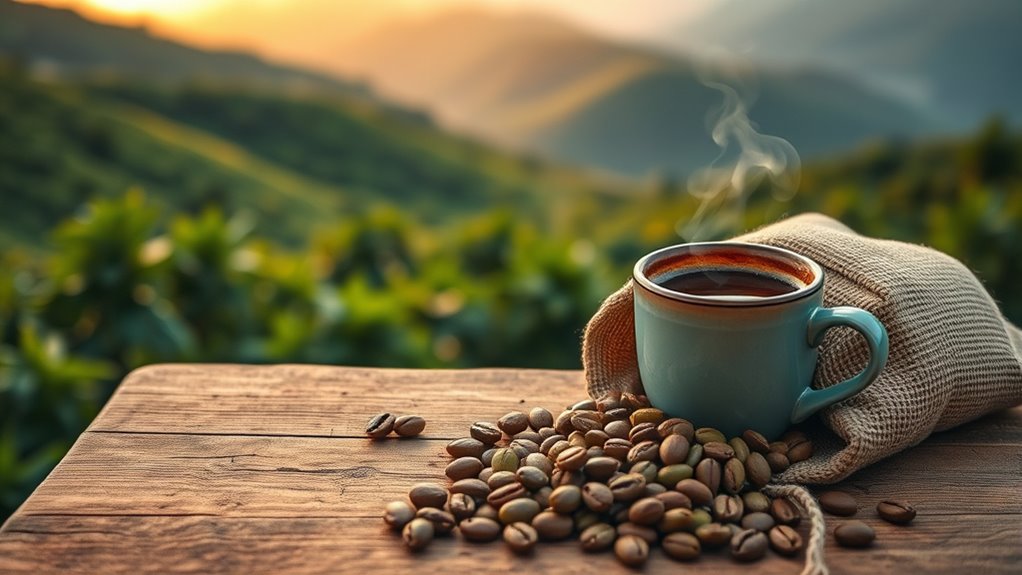
Coffee first arrived in Colombia in the 1700s when Jesuit priest Francisco Romero introduced it as a form of penance for local farmers. This marked the beginning of Colombian coffee’s rich history. The Jesuit priests’ efficient techniques in coffee cultivation helped spread the crop across the country, laying the foundation for its future growth. Over time, Colombian coffee gained a reputation for high-quality coffee, thanks to the country’s favorable climate and dedicated farmers. By the late 19th century, coffee became Colombia’s main export, fueling economic development. The Federación Nacional de Cafeteros was founded in 1927 to unify farmers and promote Colombian coffee globally. In 2011, UNESCO designated Colombian coffee a World Heritage Site, honoring its cultural and historical significance. Today, Colombia remains one of the world’s leading coffee producers, with a strong focus on maintaining quality standards that have become synonymous with its coffee heritage.
The Unique Geography and Climate That Shape Coffee Quality

Colombia’s rugged mountainous landscape, dominated by the Andes, creates the perfect environment for high-altitude coffee. These elevations, reaching up to 6,400 feet, produce high-altitude coffee with vibrant flavors and bright acidity. The volcanic soils enrich the land, giving Colombian coffee its distinctive complexity. Microclimates across the coffee belt—an ideal latitude zone—allow for precise control over growing conditions, ensuring consistent quality. The steep slopes, often shaded by banana plants, promote shade-grown coffee, which enhances bean development and preserves soil health. Colombia’s stable climate, with regular rainfall and moderate temperatures, supports year-round flowering and harvesting. All these factors combine to shape the exceptional quality of Colombian coffee, making it a global benchmark for flavor and character.
Exploring the Distinct Coffee Regions of Colombia
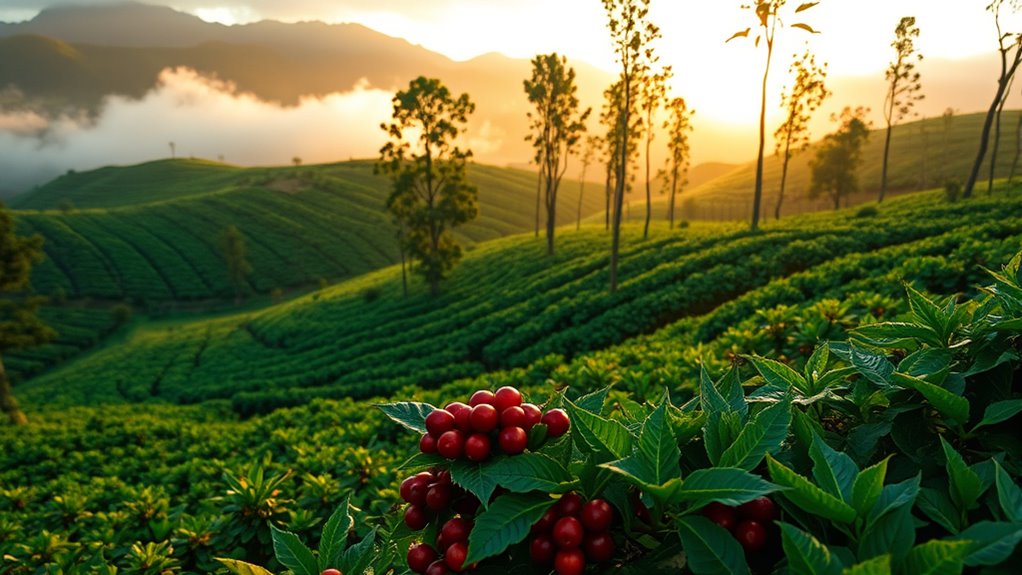
You’ll find that Colombia’s diverse coffee regions each offer a unique taste experience, shaped by their distinct microclimates and terrain. The Coffee Triangle—comprising Caldas, Risaralda, and Quindío—is famous for its lush landscapes, high-quality Arabica beans, and rich cultural heritage. In Nariño, high altitudes and volcanic soils produce coffee with bright acidity and fruity notes. Huila and Santander are known for bold, full-bodied coffees with chocolate and nutty flavors, thanks to their fertile volcanic soils and mountainous terrain. Each region cultivates specific coffee varieties like Caturra, Castillo, and Bourbon, which develop unique flavor profiles depending on local conditions. Additionally, the microclimate of each area plays a crucial role in shaping the distinct flavor characteristics of Colombian coffee. Exploring these regions reveals Colombia’s remarkable diversity in coffee, blending geography, climate, and tradition into every cup.
The Cultivation and Harvesting Process in Colombian Coffee Farms

You’ll see that Colombian coffee cultivation starts with choosing the right seeds, which are carefully nurtured before being planted in high-altitude areas. As the plants bloom, bees and birds help pollinate the flowers, shaping the beans’ development. When harvest time comes, workers pick only the ripest cherries by hand, ensuring top-quality beans for processing. To support the health and quality of the plants, farmers often incorporate nutritional benefits of chia seeds into their soil management practices, promoting overall plant vitality.
Seed Selection and Planting
Have you ever wondered how Colombian coffee starts its journey from seed to cup? It all begins with seed selection. Farmers choose high-quality seeds from renowned varieties like Caturra, Typica, or Geisha, suited to local climate conditions. These seeds are carefully germinated in nurseries, ensuring healthy seedlings for planting. During the planting process, farmers focus on precise spacing and use native shade trees like banana plants to support growth and biodiversity. Planting on steep slopes with well-drained volcanic soil enhances bean flavor and quality. This meticulous approach to seed selection and planting forms the foundation of Colombia’s exceptional coffee.
| Step | Description |
|---|---|
| Seed Selection | Choosing high-quality seeds from preferred varieties for ideal growth. |
| Germination | Seeds are germinated in nurseries before transplantation. |
| Planting Process | Careful planting with proper spacing and shade management. |
Hand-Picking and Processing
In Colombian coffee farms, hand-picking is the only way to harvest ripe cherries, guaranteeing the highest quality beans. You’ll notice how skilled pickers carefully select only the ripe cherries, which is essential for ideal flavor development. This meticulous harvesting process allows you to distinguish and pick cherries at their peak ripeness, a critical step for premium coffee. This process is often complemented by vetted methods that ensure consistency and quality in every batch. After harvesting, the cherries go through processing methods like washed or natural techniques to prepare the beans for roasting. This artisanal approach supports small farms and preserves traditional methods passed down through generations. Working on steep slopes and rugged terrain, pickers use manual tools to ensure each cherry is carefully selected. This dedication to hand-picking and processing maintains Colombian coffee’s unique quality and rich flavor profile.
The Types of Coffee Beans and Flavor Profiles Unique to Colombia
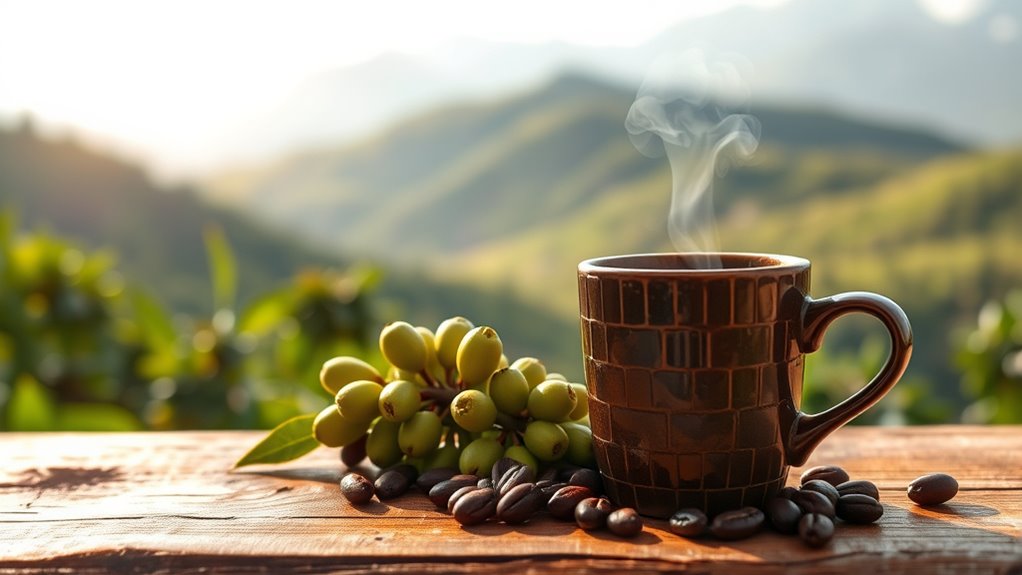
Colombia’s coffee scene is shaped by regional differences and unique processing methods that create distinctive flavor profiles. As you explore, you’ll notice how Arabica beans dominate, offering sweeter, more nuanced tastes than Robusta. Each region’s microclimate and soil contribute to flavors like fruity, floral, or chocolatey notes, making Colombian coffee truly diverse. Additionally, the emphasis on body awareness during processing and tasting enhances appreciation for the subtle variations in each cup.
Regional Variations in Flavor
The diverse geography of Colombian coffee regions creates a rich tapestry of flavor profiles that cater to various palates. In high-altitude cultivation areas above 1,200 meters, beans develop vibrant, aromatic qualities, enhancing regional flavor profiles. Different coffee varieties like Caturra, Castillo, and Typica bring distinct taste qualities, from bright acidity to smoothness. Microclimates and soil composition further influence flavor notes such as berry, citrus, caramel, and floral hints, especially in regions like Nariño and the Coffee Triangle. Specialty coffees like Gesha and Laurina are cultivated in specific microclimates, offering unique floral and fruity profiles. This regional diversity guarantees a wide spectrum of coffee experiences across Colombia. Additionally, the regional soil composition plays a significant role in shaping the unique flavor notes found in different areas.
Arabica’s Distinct Characteristics
Arabica beans dominate Colombian coffee, prized for their sweet, mild, and aromatic qualities that define the country’s coffee identity. Colombian coffee beans grown in high-altitude regions develop complex flavor profiles, featuring bright acidity and fruity or floral notes. The diverse microclimates across regions like Huila and Quindío create unique Arabica characteristics, from citrusy and lively to nutty and chocolatey. These beans are celebrated in the specialty coffee world for their balanced body and clean, crisp taste. The high-altitude cultivation enhances the beans’ quality, making Colombian Arabica a symbol of refined taste. Additionally, cold-pressed vegetable juice techniques help preserve the beans’ natural oils, contributing to their vibrant flavors. If you seek a nuanced coffee experience, Colombian Arabica’s distinct characteristics provide a perfect reflection of the country’s rich terroir and dedication to high-quality coffee.
Unique Processing Methods
Unique processing methods transform Colombian coffee beans into distinct flavor profiles that showcase the country’s diverse terroir. Techniques like honey processing and micro-lot harvesting emphasize Colombia’s specialty coffee scene, highlighting Arabica beans’ versatility. Honey processing involves partial pulp removal, creating sweeter, richer flavors, while natural processing results in bolder, fruity notes. Fermentation plays a key role in developing complexity. Regional differences, such as high-altitude areas, influence acidity and floral qualities. Here’s a quick overview:
| Method | Flavor Profile |
|---|---|
| Washed | Bright, clean, citrus |
| Natural | Fruity, bold, tropical |
| Honey Processing | Sweet, complex, caramel-like |
| Micro-lot Harvesting | Unique, nuanced, exclusive flavors |
| Fermentation | Adds depth and enhances aroma |
These methods underscore Colombia’s reputation for diverse, high-quality coffee.

Have you ever noticed how central coffee is to daily life in Colombia? It’s more than just a beverage—it’s part of the vibrant coffee culture that shapes social rituals and community bonds. Colombians often start their afternoons with a small cup of tinto, a strong black coffee, or enjoy café con leche with family and friends. Sharing these traditional coffees is a cherished custom, symbolizing warmth and hospitality. During peak hours between 3 pm and 7 pm, people gather regularly to sip coffee and connect. The image of Juan Valdez embodies this proud tradition, representing Colombia’s rich coffee heritage. Coffee isn’t just a drink here; it’s woven into art, music, and daily interactions, reflecting the country’s deep-rooted love for its traditional coffee. Properly brewed coffee can also be seen as a social ritual, fostering bonds and community among locals.
Juan Valdez and the Branding of Colombian Coffee
How did a fictional character become the global symbol of Colombian coffee? Juan Valdez was created in 1958 by Colombia’s National Federation of Coffee Growers to promote their high-quality coffee worldwide. Depicted with his mule Conchita, he represents the hardworking coffee farmers and the rural roots of Colombian coffee. Over time, Juan Valdez has become an iconic brand, with more than 300 coffee shops both in Colombia and internationally. His image and branding emphasize Colombia’s reputation for premium, 100% Colombian coffee. The protected trademarks associated with Juan Valdez reinforce the country’s identity as a top-tier coffee producer. This branding strategy has profoundly boosted Colombia’s global reputation, making Juan Valdez a symbol of quality and tradition in Colombian coffee. Additionally, the emphasis on coffee quality helps maintain Colombia’s position as a leading exporter of Arabica beans known for their distinct flavor profiles.
Sustainable Practices and Quality Control in Colombian Coffee Production
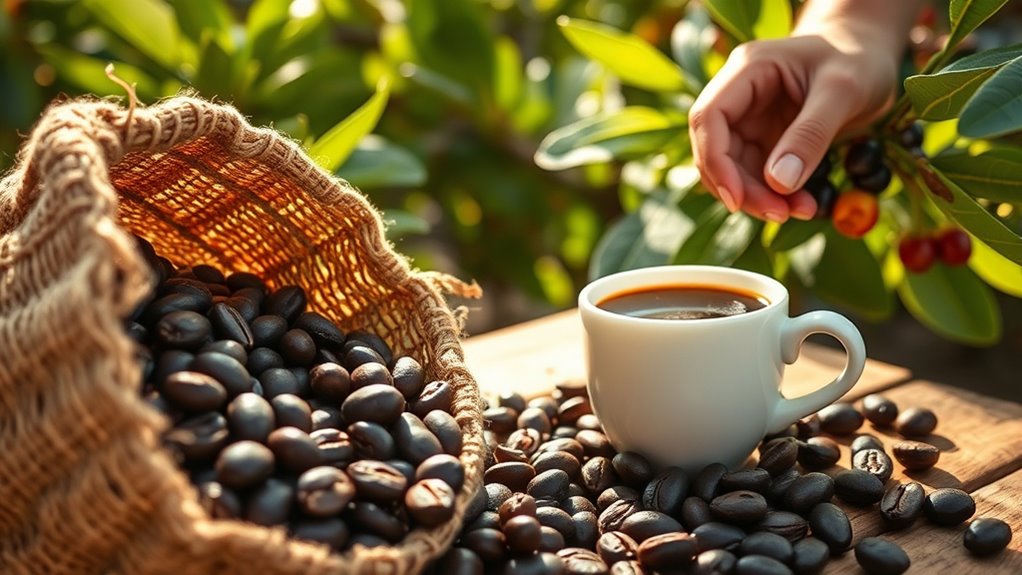
Colombian coffee producers prioritize sustainable practices and rigorous quality control to maintain their reputation for excellence. They guarantee high export standards through strict testing and inspection processes. Small farmers play a vital role and benefit from support in adopting eco-friendly farming techniques, such as shade-grown cultivation and organic fertilizers, which help preserve biodiversity and soil health. Certification programs like Rainforest Alliance and Fair Trade further guarantee environmentally sustainable and socially responsible coffee. By combining these efforts, Colombia produces sustainable coffee that meets global expectations. To deepen your understanding:
Colombian coffee emphasizes sustainability, quality control, and support for small farmers through eco-friendly practices and certifications.
- Sustainable practices support environmental preservation
- Quality control ensures premium export standards
- Small farmers are empowered through training
- Certification programs promote eco-friendly and fair trade practices
- Implementing quality control measures is essential for maintaining high standards.
Exporting Colombia’s Coffee and Its Global Impact

Colombia ranks as the third-largest global coffee exporter, with around 75% of its coffee production designated for international markets. You’re likely familiar with Colombian coffee’s reputation for high-quality Arabica beans, which meet strict international standards through rigorous testing. Exporting Colombia’s coffee supports millions of livelihoods, making it a cornerstone of the country’s economy and cultural identity. Most coffee exports come from small family-run farms that contribute considerably to Colombia’s coffee heritage. As a key player in the world coffee market, Colombia’s coffee exports boost global demand while showcasing the country’s renowned quality and tradition. This vibrant export sector not only sustains local communities but also reinforces Colombia’s reputation as a leading producer of premium coffee worldwide.
Experiencing Colombian Coffee: Tasting, Tours, and Cultural Immersion
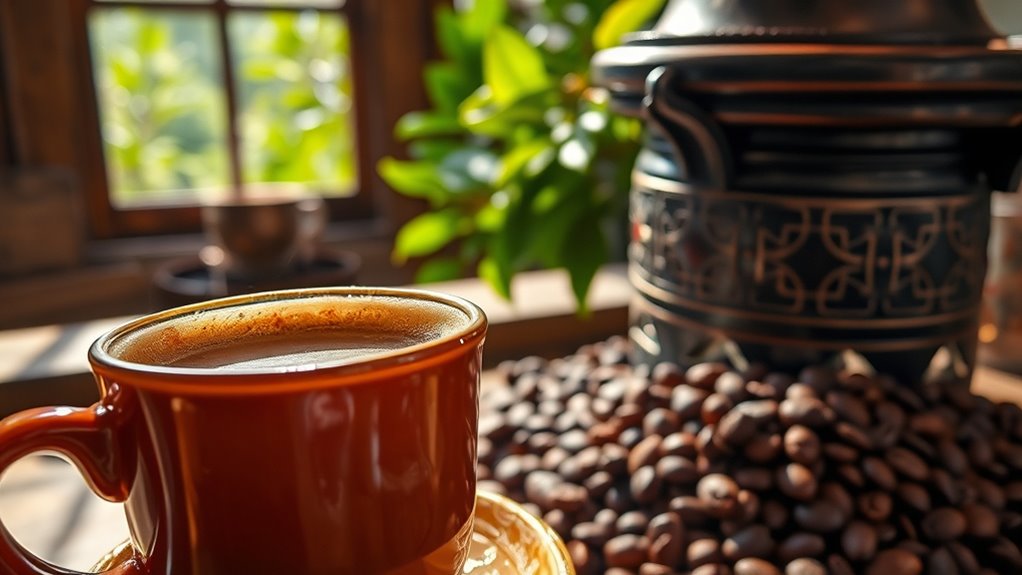
You can immerse yourself in Colombian coffee through engaging tasting workshops where experts highlight aroma and flavor nuances. Guided farm tours let you see the entire process, from bean picking to brewing, while local festivals celebrate coffee culture with lively activities. These experiences offer a true taste of Colombia’s rich coffee heritage and vibrant traditions.
Coffee Tasting Workshops
Participating in coffee tasting workshops offers an immersive way to appreciate Colombia’s rich coffee heritage. You’ll learn to identify flavor notes like fruity, floral, nutty, and chocolatey profiles that vary by region. These workshops often include guided tours of coffee farms and processing facilities, showcasing traditional methods such as hand-picking and wet or natural processing. As you taste, you’ll practice techniques like slurping to aerate the coffee and *reveal* its aromatic complexity, enhancing your sensory appreciation. Understanding regional differences becomes clear as you compare how altitude, soil, and climate influence flavor profiles. Additionally, cultural elements like pairing coffee with local snacks, listening to traditional music, and exploring Colombian coffee history deepen your connection to the craft and heritage behind each cup.
- Engage your senses through guided tastings
- Discover regional flavor distinctions
- Experience traditional processing methods
- Immerse yourself in Colombian coffee culture
Guided Coffee Farm Tours
Guided coffee farm tours offer an immersive glimpse into Colombia’s rich coffee heritage, allowing you to witness traditional cultivation and harvesting practices firsthand. As you explore small family-owned farms, you’ll learn about coffee cultivation methods, such as hand-picking ripe cherries and processing techniques like washed or natural methods. These tours often include coffee tasting sessions, where you can sample freshly brewed Colombian coffee and experience regional flavor profiles. You’ll also gain insights into Colombia’s vibrant coffee culture, from the history of iconic figures like Juan Valdez to the significance of coffee in local communities. Set against scenic landscapes in renowned coffee regions like the Coffee Triangle, these tours provide a unique opportunity to connect with Colombia’s coffee legacy through education and cultural exchange.
Cultural Coffee Festivals
Colombia’s vibrant coffee festivals, held throughout the year in regions like Manizales and Armenia, offer an authentic window into the country’s rich coffee culture. These events showcase traditional brewing customs through coffee tasting sessions, where you can savor regional flavors and learn brewing techniques like “tinto” and “café con leche.” Participating in coffee plantation tours lets you see firsthand how coffee is grown, processed, and prepared. The festivals also feature cultural activities such as folk music, dance, and artisan markets, deepening your connection to Colombian heritage. Attending these festivals helps you:
- Appreciate the history and social significance of coffee
- Understand diverse regional flavor profiles
- Experience Colombian hospitality and traditions
- Immerse yourself fully in the country’s coffee culture
Frequently Asked Questions
What Is the Coffee Tradition in Colombia?
You’re curious about Colombian coffee tradition, and it’s rich and deeply rooted in the country’s culture. You’ll find that hand-picking ripe cherries demonstrates respect for nature and guarantees quality. Coffee is more than a drink; it’s a social ritual, enjoyed in small cups called “tinto” with friends and family. This tradition, symbolized by Juan Valdez, highlights Colombia’s pride in its coffee heritage.
What Is the Quality of Coffee in Colombia?
You’ll find that Colombian coffee is renowned for its high quality, thanks to the country’s ideal growing conditions and strict standards. The beans are mostly 100% Arabica, offering rich flavor, aroma, and balanced acidity. Hand-harvesting and careful processing guarantee only the best cherries make it to market. Rigorous testing and grading uphold its reputation, so you can enjoy a consistently exceptional coffee experience with unique regional profiles.
What Are the Qualities of Colombian Coffee?
You’ll find that Colombian coffee boasts a rich, smooth flavor with bright acidity and fruity, floral, and nutty notes. The high-altitude regions and careful hand-harvesting guarantee only ripe cherries are selected, resulting in superior quality. Microclimates give each bean unique taste profiles, while strict quality control and sustainable practices keep Colombia’s coffee highly prized worldwide. You can expect a well-balanced, aromatic cup every time.
Does Colombia Have a Rich Coffee Culture?
You might wonder if Colombia has a rich coffee culture, and it truly does. Coffee isn’t just a drink here; it’s a way of life. You’ll find locals hand-picking cherries, sharing “tinto,” and celebrating with festivals like the UNESCO-recognized Coffee Cultural Landscape. Coffee’s presence in daily routines and social gatherings proves it’s deeply woven into Colombia’s identity, making your experience there even more authentic and memorable.
Conclusion
As you savor Colombian coffee, you taste centuries of tradition woven into every sip. The lush landscapes and passionate craftsmanship create a symphony of flavors that dance on your palate, transporting you to sun-kissed plantations and vibrant communities. It’s more than just a beverage — it’s a living legacy, a liquid melody that embodies Colombia’s soul. Embrace each cup as a journey through history, nature, and artistry, forever connecting you to this rich coffee tapestry.
